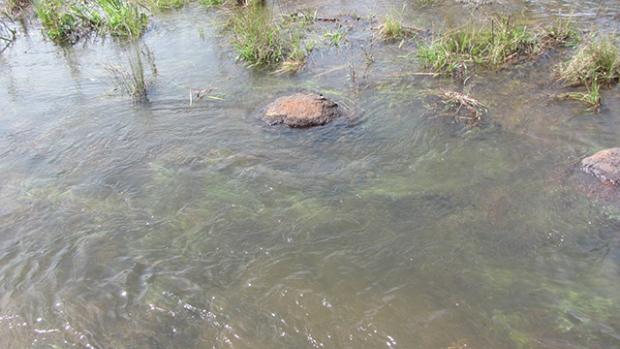Loading
The slimy circle of life

To most of us, the green slime that gathers on sticks, logs and rocks in our rivers is simply something we keep away from to avoid slipping and falling in.
However, when it comes to the health of our rivers, there is nothing more important than slime.
Slime, or biofilm as it is actually called, is at the bottom of the food chain. Big fish eat little fish, little fish, water rats and platypus eat water bugs, and water bugs eat slime.
During summer, slime that is sitting out of the water can dry off and die, and slime that is in water for too long becomes unappetising for water bugs and loses its nutritional value.
“Managing slime is a real balancing act, but one that is vital for the health of the river,” North Central Catchment Management Authority Manager Trent Gibson said.
“Slime that is scoured off a rock or a log by flowing water regrows almost immediately. When it regrows, it is much more appetising and nutritious for water bugs.
“The more fresh, growing slime there is, the more water bugs there are, and the bigger and stronger those water bugs become. The more water bugs there are, the more fish, water rats and platypus there are. It really is slimy circle of life.”
Rivers naturally go up and down, especially in spring and summer, and that’s when the slime benefits most.
“If you have a constant water level in a river, you lose the productivity of the slime,” Mr Gibson said.
“If water levels remain low, as they often do in summer, the slime dries off and dies and is inaccessible to water bugs. That will all lead to a cap on the number of water bugs.”
The North Central CMA will manage a flow down the Loddon River and Serpentine Creek in the coming weeks, with one of the aims keeping the slime – and the bugs, fish, platypus and water rats – alive.
“If we didn’t do these flows, the water bug population would be very poor, which would affect the populations of native fish and platypus,” Mr Gibson said.
“Summer flows are really important for rivers, especially in this part of the world. These flows will capitalise on the recent spring water for the environment flows and help minimise the risk of toxic blackwater events during the hottest part of the year.
“Our spring flows washed lots of the leaf litter away, which is the first step in preventing blackwater. These flows will keep the water moving and connect the water between pools.
“Connecting pools gives all kinds of fish a chance in summer and keeps them away from predators such as larger, or more aggressive fish.
The flows are also aimed at improving water quality along the waterways and giving vegetation on the banks and emerging from the water a much-needed drink.
Up to 100 megalitres a day will flow down the Loddon from Cairn Curran to the Murray. Up to 40ML a day will flow down Serpentine Creek for up to three days.
“Once this water hits the Murray it goes back into the consumptive pool,” Mr Gibson said.
The flows are part of the Victorian Government’s $222 million investment over the next four years to improve the health of waterways and catchments and are authorised by the Victorian Environmental Water Holder in line with its Seasonal Watering Plan 2018-19.
The VEWH Seasonal Watering Plan 2018-19 is available for download from www.vewh.vic.gov.au, with regular watering updates here.
